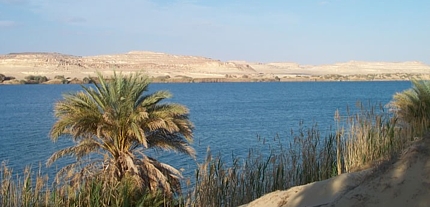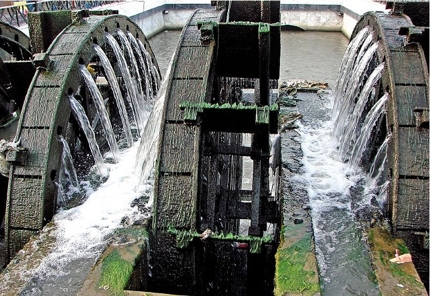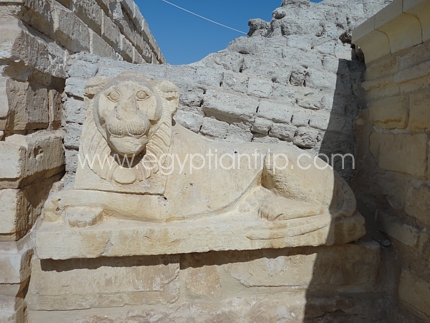
|
| Fayoum is a city in Middle Egypt. Located 130 km (81 mi) southwest of Cairo, it is the capital of the modern Fayoum Governorate. The town occupies part of the ancient site of Crocodilopolis. Founded in around 4000 BC, it is the oldest city in Egypt and one of the oldest cities in Africa. Fayoum Oasis is a wonderful bird watching destination, well known for its delicious fruits and vegetables. Birds migrate to the oasis for the lush plants and the waters of Lake Quarun, the largest salt water lake in Egypt. Here you’ll find Grebes, coots, ducks and shorebirds during winter. In its South-Western part, the Fayoum depression is also home to the Rayyan Valley, or Wadi Ar-Rayyan, which covers 11,450 hectares of lakes, 1,580 hectares of wetlands and 160,949 hectares of desert lands. The area has been declared as a protected area in 1989. Being near from Cairo, the area is visited yearly by Only hundreds or thousands of Egyptians and foreign tourists who enjoy the natural features of the protectorate. The Name Its name in English is also spelled as Fayum, Fayoum, Al Fayyum or El Faiyūm. Faiyum was previously officially named Madīnet el Faiyūm (Arabic for The City of Faiyum). The name Faiyum (and its spelling variations) may also refer to the Faiyum Oasis, although it is commonly used by Egyptians today to refer to the city.  The modern name of the city comes from Coptic 'efiom/peiom (whence the proper name payom), meaning the Sea or the Lake, which in turn comes from late Egyptian pA y-m of the same meaning, a reference to the nearby Lake Moeris. The modern name of the city comes from Coptic 'efiom/peiom (whence the proper name payom), meaning the Sea or the Lake, which in turn comes from late Egyptian pA y-m of the same meaning, a reference to the nearby Lake Moeris.
This region is extremely rich in many archaeological sites, such as the old City of El-Fayoum (Crocodopolis). It is in a natural depression in the desert, linked to the River Nile by a branch called “Bahr Yousuf”, whose name was probably derived from the ancient Egyptian Word “Baym”, which means sea or lake. It contains a lake that was known by the Ancient Egyptians as “Mr-Wr”, which means “the great sea”, and in Greek it became “Moris”. Today, in Arabic, it is called “Qaroun Lake. The word Baym was most probably the origin of the word El-Fayoum. In Ancient Egypt it was called “shedt” and it was a great city during the Middle Kingdom. Faiyum is the source of some famous death masks or mummy portraits painted during the Roman occupation of the area. The Egyptians continued their practice of burying their dead, despite the Roman preference for cremation. While under the control of the Roman Empire, Egyptian death masks were painted on wood in a pigmented wax technique called encaustic—the Faiyum mummy portraits represent this technique. While commonly believed to represent Greek settlers in Egypt, the Faiyum portraits instead reflect the complex synthesis of the predominant Egyptian culture and that of the elite Greek minority in the city. |
View Larger Map 

|
|

What to visit in Fayoum? The Historical sites & the Monuments The pyramid of Hawara The Labyrinth  The bizarre looking pyramid of Hawara was built by the king Amenemhat III during the reign of the 12th dynasty, nine kilometers to the South East of the modern city of Fayoum today. Amenemhat III was the sixth king of the 12th dynasty. He ruled from 1860 BC to 1814 BC. This king had special interest in the area of the Fayoum and this was why he chose this spot to build this pyramid to serve as his tomb after his death. The Pyramid of Hawara was built out of mud bricks and was coated with limestone and maybe this is why it was called the black pyramid. The Pyramid is 58 meters tall and the length of its sides is around 100 meters. The pyramid of Hawara is quite distinctive in its shape and its design. This monument is really worth going to, especially since it is located near the city of Fayoum. The Pyramid of EL-Lahun The pyramid of Lahun was built by the king Senusret II near the water dam he built near the city of Lahun, 22 kilometers to the South of the modern city of Fayoum. Senusret II, the fourth king of the 12th Dynasty of Egypt, ruled from 1897 BC to 1878 BC. This king gave particular attention to the Fayoum region and began to work on an irrigation system through the construction of a dike at El Lahun. This was where he built his pyramid as well. The pyramid was discovered and opened by the English scientist William Flinders Petrie in 1889. The pyramid of Senusret II in Lahun was built on a high hill that is 13 meters high and it was constructed out of mud bricks, the same as the Pyramid of Amenemhat III which was built in Hawara. The pyramid is 48 meters high and the length of its base is 106 meters. The pyramid, the same as many pyramids that were constructed in the area, was coated with limestone. The area hosts a number of other sites like the necropolis of Lahun, the workers villages, and the tomb of mkat that goes back to the 13th dynasty. The ancient city of Karanis The ruins of the ancient city of Karanis are located near the village of Kom Aushim on the Fayoum-Cairo highway, 1.9 kilometers away from the city of Fayoum, 33 kilometers away from Cairo. The city's center consists of the ruins of two temples dedicated to the crocodile god of Sobek. There are also a big number of houses, a roman bath, and the necropolis of the city is located to the North. Kom Oushim Karanis (Kom Oushim) is situated 30Km north of the city of El-Fayoum. In old Greek documents this region was called Karanis and it contains 2 Temples in the north and another in the south, both dating back to the Ptolemaic Period, as well as some cisterns, public baths and houses etc. The Kelsey Museum houses more than 45,000 objects from Karanis. A dwelling area was discovered in Karanis, the houses built out of mud-bricks, and red bricks, with vaulted roof and stairs, gates, windows, kitchens, and stables. Some walls were painted and covered with colorful decorations.  Madinat Madi Madinat Madi is located 35 kilometers south east the city of Fayoum near the village of Ezbat El Kashef and it was discovered in the year 1937. Madinat Madi contains the ruins of a city that was built around a temple constructed during the 12th dynasty by the king Amenemhat III who was the sixth king of the 12th dynasty and ruled from 1860 BC to 1814 BC. He is also the builder of the Pyramid at Hawara. This temple of Madinat Madi is the largest surviving temple of the intermediate period of the Pharonic era and it is considered the most remarkable monument of the Fayoum. Qasr Qarun Qasr Qarun is located 50 kilometers away from the city of Fayoum in the south west of the Qarun Lake that dominates the Northern section of the Fayoum. Qasr Qarun was built in the location of the ancient town of Dionysias, which was the beginning point of the caravan route to the Bahariya Oasis. This impressive monument was built between 323 and 330 BC during the Ptolemaic period and it flourished in the Roman era. The temple still sustains the beauty of its wall drawings and inscriptions. It consists of three floors and contains 336 rooms and chambers. The first thing one views when he enters the temple is the throne of the king and a very deep hole that the myth say it contains all the money and jewelry of King Qarun who was drowned with all his treasures because he angered god according to the Quran. Dimeh Al Siba It is located 3 kilometers to the North of the Qarun Lake. It consists of the city of Ptolemaic city that was founded by Ptolemy II, most probably, in the third century BC. This city was the starting point of the caravan rout going to the other oasis of Egypt located to the South. The ruins of this city, the city of the lions, contain the temple which was built out of Limestone and sandstone contains seven Compartments. The city was built over a space of 180 meters and its walls are still surviving until today. The Obelisk of Senusret It consists of a tall bar of granite that is 13 meters long and it has a round shape top. The obelisk contains a hall to install a crown or a statue of the king. The obelisk was built by Senusert who was the second pharaoh of the 12th Dynasty. He ruled from 1971 BC to 1926 BC, and was one of the most powerful leaders of his era. The obelisk was built in the memory of the beginning of the working process to transform the lands of the Fayoum into agriculture lands. The Obelisk of Senusret was transferred from its original place in the village of Abgig in Fayoum to the entrance of the city in 1972. This Obelisk is considered a landmark of Fayoum. Natural Places Lake Qarun Lake Qarun has been a source of fish and a habitat for waterfowl since time immemorial. The lake's main water source is drainage from agricultural land, which enters through two major drains called el-Batts and el-Wadi. This water has become increasingly saline as agriculture has intensified and the water is now more saline than seawater. Freshwater fish and invertebrates have largely disappeared and marine species have been introduced. This lake is of international importance for wintering waterbirds including Black-necked Grebe, Podiceps nigricollis, and Northern Shoveller, Anas clypeata. A fruitful day can be spent here in el-Fayoum (1h30 driving distance from Cairo) seeing the numerous ancient sites including the small but excellent museum.  Wadi el-Rayan The natural protected area of Wadi El-Rayan is a small valley southwest of the Fayoum oasis, the closest Western Desert oasis to Cairo (2 hours driving distance). Two man-made lakes, created by agricultural run-off water from the Fayoum oasis, are joined by a channel and charming waterfalls. The upper lake is densely vegetated whereas the lower lake is brackish and its shores are poorly vegetated. The lakes are wintering habitat for water birds migrating from south and north to Egypt. What to See around Fayoum ? Maidum Pyramid Built by the pharaoh Snefru, the Father of Khufu, the pyramid of Maidum seems to stand alone on the edge of the desert, close to several smaller mastabas. The eight layers structure is believed to be the first attempt at a true pyramid and it is the first Egyptian pyramid to have an above ground burial chamber with beautiful and innovative arch-shaped walls. Nowadays, you can only see the highest three levels of the pyramid, protruding through the sands and collapsed debris, in an aura of strength. Wadi El Hitan Valley of the Whales Within two hours driving distance from Cairo, in the Fayoum area, you’ll discover a yet more impressive meaning of “Ancient” Egypt. The remote valley of Wadi El-Hitan (Valley of the Whales) is more of an open-air museum displaying rare gigantic fossils of ancient whales and sharks proving that some 40 to 50 million years ago, the area was submerged in the waters of what is known as the Tethys Sea. After lying trapped in the sands of the Western Desert, the fossil skeletons have been revealed by winds and erosion, and thanks to human intervention through a number of ongoing archaeological excavations sponsored by the National Geographic Society and by the University of Michigan.  The landscapes surrounding the valley are just as impressive and amazing as the discoveries: gigantic sand rocks and mountains, dunes and hills. Try to visit the valley around sunset for a magical experience; the views and the colours are just amazing at that time of the day. The Valley of the Whales is part of the WRPA (Wadi El-Rayan Protected Area) and it has also been added in 2005 to the UNESCO's World Heritage List for its unique natural beauty and scientific significance. The Wadi Al-Rayan protectorate can only be reached by a private car or taxi, taking the Fayoum Desert Road from Cairo. A 4X4 vehicle would be a good choice, since the road becomes pretty bumpy after leaving Fayoum. Top activities to do in Fayoum Fishing in Lake Qarun and the Lakes at Wadi El Rayan Lake Qarun abounds with fish, especially Bulti, which is said to be better than the bulti caught from the Nile itself. Large quantities of Bulti caught here are sent to Cairo. Mullet, eel, sole and shrimp are also available as the lake becomes saltier. The new Wadi Rayyan lakes are also now open for fishing Nile carp and Nile perch. At 215 square km, Lake Qarun, Egypts largest salt water lake, is open to fishing from Mid-June to Mid April. The Lake used to be known as Berket Al-Said (the Fishing Lake). One night in 1245, a cold wind blew, freezing the lake and all the fish in it. A canal overseer walking along the shore the next morning reported seeing thousands and thousands of fish, layered according to species and stacked up like bricks of a house. Discovery of prehistoric fishing tackle last year at the Fayyoum Oasis confirms the area’s status as hunting and fishing paradise as far back as 7200BC. Its popularity as an elite hunting retreat continued from the Pharaohs who built vacation palaces here through to the late King Farouk, whose hunting lodge there has been converted to a hotel at Lake Qarun.  Bird Watching Fayoum Oasis Bird Watching Fayoum Oasis is a wonderful bird watching destination, well known for its delicious fruits and vegetables. Birds migrate to the oasis for the lush plants and the waters of Lake Quarun, the largest salt water lake in Egypt. Here you’ll find Grebes, coots, ducks and shorebirds during winter. In its South-Western part, the Fayoum depression is also home to the Rayyan Valley, or Wadi Ar-Rayyan, which covers 11,450 hectares of lakes, 1,580 hectares of wetlands and 160,949 hectares of desert lands. The area has been declared as a protected area in 1989. Being near from Cairo, the area is visited yearly by Only hundreds or thousands of Egyptians and foreign tourists who enjoy the natural features of the protectorate. | ||
|
|
|